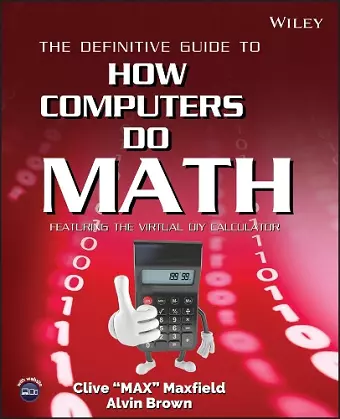The Definitive Guide to How Computers Do Math
Featuring the Virtual DIY Calculator
Alvin Brown author Clive Maxfield author
Format:Paperback
Publisher:John Wiley & Sons Inc
Published:21st Oct '05
Currently unavailable, and unfortunately no date known when it will be back

The Basics of Computer Arithmetic Made Enjoyable and Accessible-with a Special Program Included for Hands-on Learning
"The combination of this book and its associated virtual computer is fantastic! Experience over the last fifty years has shown me that there's only one way to truly understand how computers work; and that is to learn one computer and its instruction set-no matter how simple or primitive-from the ground up. Once you fully comprehend how that simple computer functions, you can easily extrapolate to more complex machines."
-Fred Hudson, retired engineer/scientist
"This book-along with the virtual DIY Calculator-is an incredibly useful teaching and learning tool. The interesting trivia nuggets keep you turning the pages to see what's next. Students will have so much fun reading the text and performing the labs that they won't even realize they are learning."
-Michael Haghighi, Chairperson of the Business and Computer Information Systems Division, Calhoun Community College, Alabama
"At last, a book that presents an innovative approach to the teaching of computer architecture. Written with authority and verve, witty, superbly illustrated, and enhanced with many laboratory exercises, this book is a must for students and teachers alike."
-Dr. Albert Koelmans, Lecturer in Computer Engineering, University of Newcastle upon Tyne, UK, and the 2003 recipient of the EASIT-Eng. Gold Award for Innovative Teaching in Computer Engineering
Packed with nuggets of information and tidbits of trivia, How Computers Do Math provides an incredibly fun and interesting introduction to the way in which computers perform their magic in general and math in particular. The accompanying CD-ROM contains a virtual computer/calculator called the DIY Calculator, and the book's step-by-step interactive laboratories guide you in the creation of a simple program to run on your DIY Calculator.
How Computers Do Math can be enjoyed by non-technical individuals; students of computer science, electronics engineering, and mathematics; and even practicing engineers. All of the illustrations and interactive laboratories featured in the book are provided on the CD-ROM for use by high school, college, and university educators as lecture notes and handouts.
For online resources and more information please visit the author's website at www.DIYCalculator.com.
"I found this book to be a lot of fun, and I think many high school teachers and students would enjoy it too." (Mathematics Teacher, September 2006)
"Clive 'Max' Maxfield and Alvin Brown have written a wonderful book…about the essential workings of computers." (The Embedded Muse, February 22, 2006)
"I have not seen a better description of the stack and related concepts. The authors obviously understand that these concepts are usually confusing to novices, and hence they support the material with good and simple examples." (Computing Reviews.com, January 16, 2006)
"It looks like Max has done it again, i.e., written another technical book that reminds us why we studied electronics in the first place--for the sheer fun of it." (Chip Design Magazine, December 2005/January 2006)
"The book is fun, highly informative, and full of vitally important stuff for both the technical and non-technical alike." (EDA Confidential, November 21, 2005)
"Everybody can learn from this lively book but it [is] especially helpful for teachers and engineers who want to share their interest in math and computing machinery with others." (Wireless Net DesignLine Newsletter, November 10, 2005)
"For those interested in a slightly off-beat approach to learning the basics of computer architectures, Maxfield and Brown have put together a multimedia package that's well worth the price of admission." (Electronic Design.com, October 20, 2005)
"The book is perfect for students and those among us who aspire to really understand what is going on in those gismos…the prose is easy to read, and the lab exercises are well designed." (Gabe On EDA.com)
ISBN: 9780471732785
Dimensions: 236mm x 193mm x 24mm
Weight: 816g
480 pages